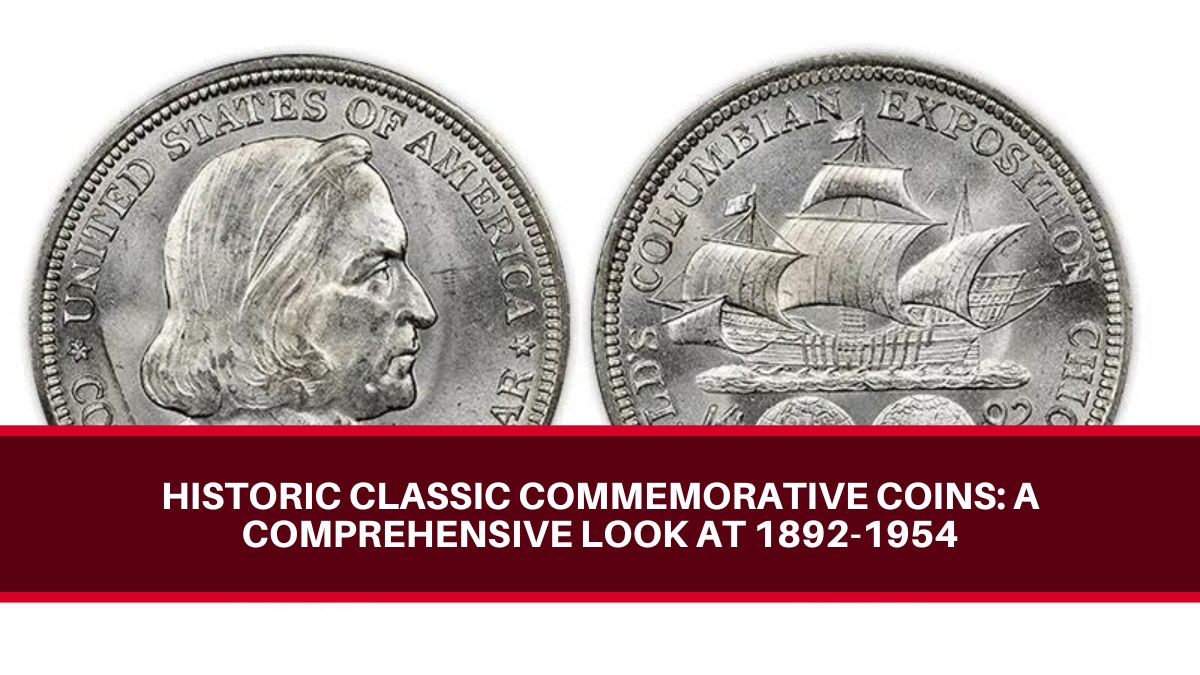Commemorative coins are special coins issued to celebrate significant events, anniversaries, or people. From 1892 to 1954, the United States Mint produced a wide range of these unique coins. They are categorized into the Classic Commemorative Era and the Modern Commemorative Era, based on their design, legislation, and production methods. This article will guide you through the Classic Commemorative Era, highlighting its key features, periods, and the coins that make it so fascinating to collectors today.
Classic Commemorative Era Overview
The Classic Commemorative Era covers 62 years, from 1892 to 1954. During this time, commemorative coins were primarily made of gold and silver. The two most common formats were the silver half dollar and the gold dollar. This period is known for its variety and the involvement of notable artists in designing the coins. However, the distribution system used during this era faced issues, including corruption and abuse, leading to a hiatus in production.
Classic Commemorative Coins Breakdown
Here’s a detailed look at the Classic Commemorative Era divided into four key periods:
| Period | Years | Features | Notable Coins |
|---|---|---|---|
| Early Years | 1892-1918 | Gold and silver coins; diverse themes and designs. | Columbian Half Dollar, Isabella Quarter, Lafayette Dollar |
| Roaring Twenties | 1920-1928 | Focus on half dollar format; celebration of state anniversaries. | Hawaiian Sesquicentennial Half Dollar, Grant Gold Dollar |
| Great Depression | 1930s | Boom in production due to Roosevelt; controversial issues and abuses. | Spanish Trail Half Dollar, Cincinnati Half Dollar |
| Post-War Era | 1946-1954 | Few new issues; mostly revisiting old themes. | Iowa Half Dollar, Washington-Carver Half Dollar |
Notable Commemorative Coins by Period
1. Early Years (1892-1918)
| Coin | Year | Details |
|---|---|---|
| Columbian Half Dollar | 1892-1893 | First commemorative coin, marking the World’s Columbian Exposition. |
| Isabella Quarter | 1893 | Issued alongside the Columbian Half Dollar, also for the Exposition. |
| Lafayette Dollar | 1900 | Celebrates the centennial of Lafayette’s death. |
| Panama-Pacific Exposition Coins | 1915 | Includes $50 gold pieces, notable for their elaborate designs. |
2. Roaring Twenties (1920-1928)
| Coin | Year | Details |
|---|---|---|
| Hawaiian Sesquicentennial Half Dollar | 1928 | Commemorates Hawaii’s 150th anniversary. |
| Grant Gold Dollar | 1922 | Honors Ulysses S. Grant. |
| Oregon Trail Half Dollar | 1926 | Features a pioneer theme, popular among collectors. |
3. Great Depression (1930s)
| Coin | Year | Details |
|---|---|---|
| Spanish Trail Half Dollar | 1935 | Controversial for its design and marketing practices. |
| Cincinnati Half Dollar | 1936 | Celebrates the centennial of Cincinnati’s incorporation. |
| Antietam Half Dollar | 1937 | Commemorates the Battle of Antietam. |
4. Post-War Era (1946-1954)
| Coin | Year | Details |
|---|---|---|
| Iowa Half Dollar | 1946 | Celebrates Iowa’s statehood centennial. |
| Washington-Carver Half Dollar | 1951-1954 | Initially Booker T. Washington, later changed to include George Washington Carver. |
Collecting Classic Commemorative Coins
Collecting these coins can be a rewarding hobby. Many collectors focus on silver coins due to their affordability and historical interest. Gold coins, while more expensive, are also popular and often collected as sets. The price of these coins can vary, and some rare issues may attract higher prices at auctions.
Price Range for Classic Commemorative Coins
| Coin Type | Price Range |
|---|---|
| Silver Issues | $250 – $500 per coin |
| Gold Issues | Starts around $100,000 |
Challenges in Investing
Investing in commemorative coins comes with challenges. Many were sold as souvenirs or collectibles, not for their investment value. Market manipulation and promotional schemes have affected their perceived rarity and value. The rise of third-party grading and online resources has improved transparency, but classic commemoratives still carry investment risks.
Conclusion
The Classic Commemorative Era of U.S. coins offers a fascinating glimpse into American history and artistry. From the early issues marking historical events to the varied and sometimes controversial coins of the 1930s, collectors have a rich field to explore. Despite market challenges, these coins remain a cherished part of numismatic history.
FAQ’s
What are Classic Commemorative Coins?
Classic Commemorative Coins are special coins issued by the United States Mint between 1892 and 1954 to celebrate significant events, anniversaries, or individuals. They are known for their distinctive designs and historical value, with common types including silver half dollars and gold dollars.
How do I determine the value of a Classic Commemorative Coin?
The value of a Classic Commemorative Coin depends on factors such as rarity, condition, and demand. Prices can range from a few hundred dollars for common silver coins to over $100,000 for rare gold issues. It’s best to consult a professional numismatist or use reputable coin pricing guides for accurate valuations.
Are Classic Commemorative Coins a good investment?
Classic Commemorative Coins can be a good investment, especially if you focus on rare or historically significant pieces. However, the market can be volatile, and the value of these coins can be influenced by factors such as historical interest and market demand. Always research and consider professional advice before investing.

